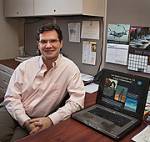At just 610 metres above the ground, wind velocity is two to three times compared to ground level wind speeds. A NASA project is looking into how to harvest this resource with airborne wind turbines.
NASA aerospace engineer Mark Moore is part of the first federally-funded research effort to examine airborne wind harvesting platforms. While Moore says the concept isn’t a clean energy panacea, it deserves consideration in a renewable energy mix.
But why stop at 610 metres – further up even more potential energy is available. At 9 kilometres above the surface is the jet stream that generates wind speeds of up to 240 kilometres per hour.
“Instead of 500 watts per meter (for ground-based wind turbines), you’re talking about 20,000, 40,000 watts per square meter,” says Moore.
To date, solid inroads into the possibility have not been made, simply because only small companies have been investigating the concept, with each company only working on one small piece of the puzzle. Moore hopes the NASA project will bring a sense of what’s going to be necessary to harvest wind power.
The placement and operation of airborne wind turbines is more than just a geographical and technological challenge – it’s a logistical one; including the interaction between sky wind farms and other competitors for airspace.
“Offshore deployment of these airborne systems probably makes the most sense in terms of both airspace and land use, because there is little to no demand for low altitude flight over oceans 12 miles (19 to 20 km) offshore.”
Source













































